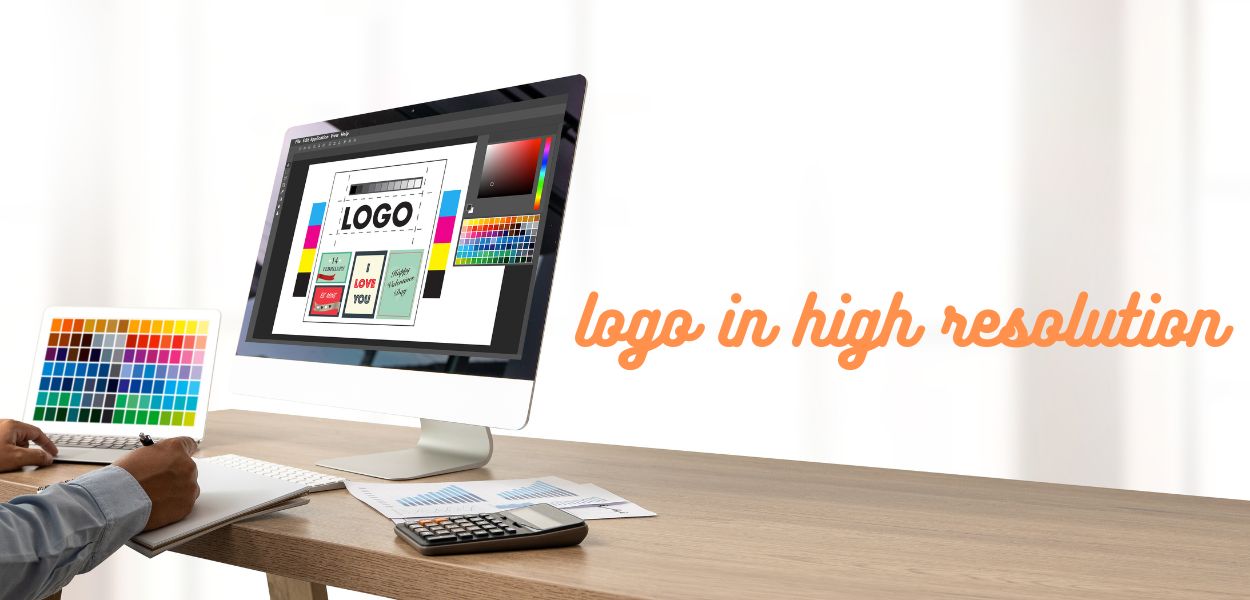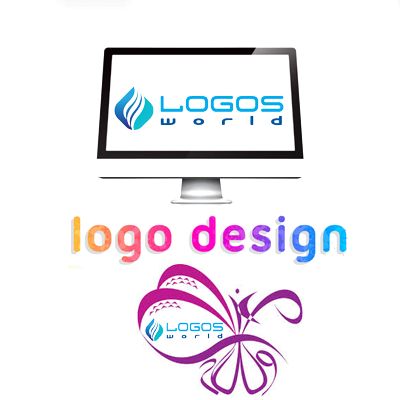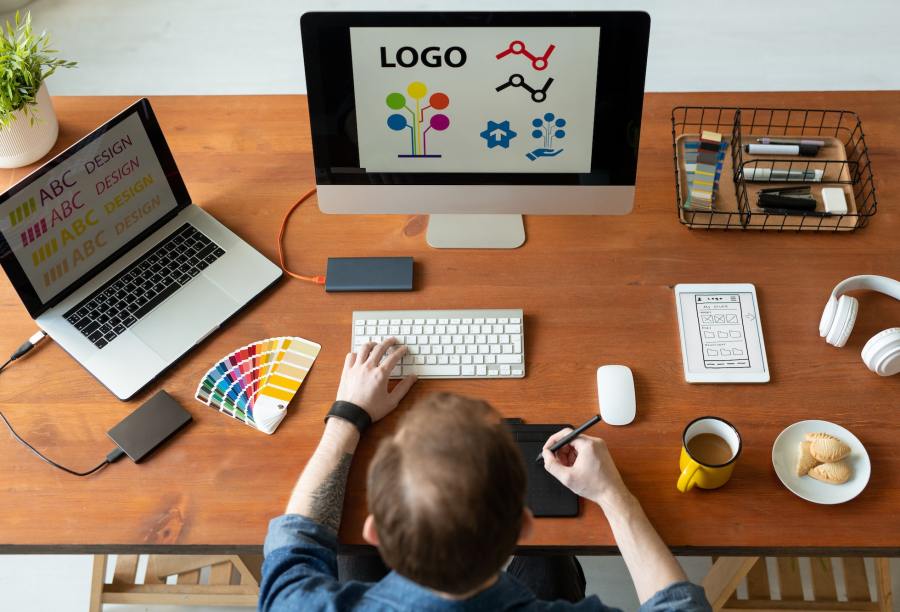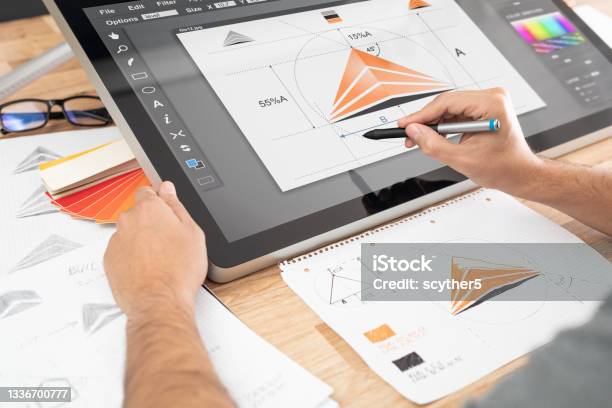
In the competitive world of small businesses, creating a strong visual identity is crucial for success. A well-designed logo and branding materials can make a lasting impression on potential customers, conveying professionalism and credibility.
This article explores the 10 essential elements for perfect logo and branding materials, from color palette selection to typography and logo design. By incorporating these elements, small businesses can create a cohesive and memorable brand that resonates with their target audience.
The Importance of a Strong Visual Identity
A strong visual identity is crucial for small businesses as it helps to establish a distinct and memorable brand presence in the market. Visual storytelling has the power to captivate the audience and create emotional connections through design.
When a small business has a strong visual identity, it communicates its values, personality, and unique offerings to its target audience. This allows customers to easily recognize and differentiate the brand from its competitors.
By incorporating visual elements such as colors, typography, and imagery, small businesses can create a cohesive and visually appealing brand identity. It is through this visual identity that businesses can evoke emotions, build trust, and establish long-lasting relationships with their customers.
The power of visual storytelling lies in its ability to convey a brand's story, values, and mission, ultimately leaving a lasting impression on customers.
Choosing the Right Color Palette
When it comes to choosing the right color palette for your small business, it's important to consider the psychology behind colors and the impact they can have on your brand.

Different colors evoke different emotions and can communicate specific messages to your target audience.
Color Psychology in Branding
During the process of creating a brand identity, it is crucial to consider the timelessness and impact of color choices in order to effectively communicate the desired message to the target audience. Color psychology plays a significant role in branding, as different colors evoke different emotions and associations.
Here are four key aspects to consider when choosing the right color palette for your brand:
Branding psychology: Understanding the psychological effects of colors can help you choose hues that align with your brand's personality and values.
Color symbolism: Colors have cultural and symbolic meanings that can influence how your brand is perceived. Research the symbolism behind different colors before making your final decision.
Target audience: Consider the preferences and cultural backgrounds of your target audience. Certain colors may resonate more with specific demographics.
Brand differentiation: Select colors that set your brand apart from competitors and help it stand out in the market.

Impact of Color Choices
Consistently choosing the right color palette is crucial for small businesses in order to create a strong and memorable brand identity. The impact of color psychology cannot be underestimated when it comes to influencing consumer behavior and perception. Different colors evoke different emotions and associations, and understanding this can help businesses create a brand that resonates with their target audience.
Color plays a significant role in brand recognition. It can help a small business stand out from competitors and communicate its values and personality. For example, bold and vibrant colors can convey a sense of energy and excitement, while softer and muted tones can evoke a feeling of calmness and sophistication.
It is important to choose colors that align with the brand's message and target market. Conducting thorough research and understanding the psychology behind different colors can help small businesses make informed decisions about their color palette, ensuring that their branding materials have a lasting impact on consumers.
Typography: Selecting the Perfect Fonts
With careful consideration, small businesses can effectively choose the perfect fonts for their branding materials through typography. Typography plays a crucial role in conveying the right message and creating a strong visual identity.
Here are four essential tips for selecting the perfect fonts:
Font Pairing: Choose fonts that complement each other and create a harmonious balance. Pair a bold, attention-grabbing font with a simpler, more legible one for a professional look.
Font Legibility: Ensure that the chosen fonts are easy to read, even at different sizes and on various platforms. Avoid overly complex or decorative fonts that may hinder readability.

Consistency: Maintain consistency across all branding materials by using the same fonts throughout your logo, website, marketing materials, and social media posts. This creates a cohesive and recognizable brand image.
Reflect your brand personality: Select fonts that align with your brand's personality and values. A modern and sleek font may be suitable for a tech company, while a more elegant and traditional font may be fitting for a luxury brand.
Creating a Memorable Logo Design
Additionally, small businesses can maximize their brand recognition by creating a memorable logo design that captivates their target audience. A logo is the face of a brand, and it plays a crucial role in creating a unique identity for a business.
To create a memorable logo design, it is important to incorporate brand values into the design process. The logo should reflect the essence of the brand and what it stands for. It should communicate the brand's values, personality, and mission. By incorporating these elements into the logo design, small businesses can ensure that their logo becomes a visual representation of their brand and leaves a lasting impression on their audience.
A memorable logo design can help small businesses stand out in a crowded market and build a strong brand presence.
Consistency in Branding Elements
To maintain a strong and cohesive brand identity, businesses must consistently align their branding elements across all marketing materials. Brand consistency is crucial for establishing brand recognition and building trust with customers.
Here are four key reasons why maintaining identity through brand consistency is essential:

Recognition: Consistency in branding elements such as logo, colors, and typography helps customers easily identify and remember your brand.
Trustworthiness: A consistent brand image conveys professionalism and reliability, making customers more likely to trust your products or services.
Differentiation: Consistent branding sets your business apart from competitors and helps you stand out in a crowded market.
Brand loyalty: By consistently delivering a cohesive brand experience, you can build a loyal customer base that identifies with your brand values and becomes brand advocates.
Effective Use of Negative Space
By strategically incorporating negative space, small businesses can create visually impactful logos and branding materials. Negative space refers to the empty areas surrounding and between design elements, and it can be used to enhance the overall visual appeal of a logo or branding material.
Using negative space techniques, such as creating hidden shapes or using contrasting colors, can make a design more interesting and memorable.
For example, the FedEx logo cleverly uses negative space to create an arrow between the letters 'E' and 'X,' symbolizing speed and precision.

Another example is the Amazon logo, where the negative space between the letters 'A' and 'Z' forms a smile, suggesting that the brand offers a wide range of products and aims to bring joy to its customers.
Small businesses can take inspiration from these negative space examples and experiment with their own designs to create impactful branding materials.
Incorporating Meaningful Symbols or Icons
When it comes to creating a logo and branding materials for small businesses, incorporating meaningful symbols or icons is crucial. Symbolic brand associations help to establish a strong connection with the target audience, while visual storytelling through icons can convey the brand's values and message in a concise and memorable way.
Furthermore, symbols have the power to evoke emotions and create a lasting impact, making them an essential element in successful branding strategies.
Symbolic Brand Associations
Symbolic brand associations play a crucial role in creating a powerful and memorable identity for small businesses. Incorporating meaningful symbols or icons into their logo and branding materials visually communicate the essence of the brand and evoke emotions. This helps businesses connect with the audience on a deeper level.
Here are four reasons why incorporating meaningful symbols or icons is essential for small businesses:
Memorability: Symbols or icons have the power to leave a lasting impression on people's minds, making the brand more memorable.

Emotional Connection: Symbols often carry hidden meanings or cultural significance. This allows businesses to establish an emotional connection with their target audience.
Simplicity: Symbols can convey complex ideas or values in a simple and concise manner. This makes them easily understandable and relatable.
Versatility: Meaningful symbols or icons can be used across various marketing materials. This ensures consistency and reinforces the brand's message.
Visual Storytelling Through Icons
One of the key strategies for enhancing brand identity is incorporating a variety of meaningful symbols or icons to visually tell a compelling story.
Visual storytelling techniques and iconography in branding can create a powerful impact on consumers, allowing them to connect with a brand on a deeper level. Icons have the ability to convey complex ideas and emotions in a simple and concise manner.
By carefully selecting and designing icons that represent the values and personality of a brand, small businesses can effectively communicate their message to their target audience. These icons can be used across various branding materials, such as logos, websites, and social media profiles, creating a cohesive and memorable visual identity.
Through the use of visual storytelling techniques and thoughtful iconography, small businesses can stand out in a crowded marketplace and leave a lasting impression on their customers.

Emotional Impact of Symbols
The emotional impact of symbols can be greatly enhanced by incorporating meaningful symbols or icons into a brand's visual identity. Symbols have the power to evoke strong emotions and create a deep connection with the audience.
Here are four reasons why incorporating meaningful symbols or icons can have a profound impact on a brand:
Symbolic Interpretations: Symbols carry inherent meanings and associations that can convey messages and ideas without using words. By using symbols that align with the brand's values and mission, businesses can communicate their identity and purpose more effectively.
Subconscious Messaging: Symbols have the ability to tap into the subconscious mind, triggering emotions and memories. By incorporating meaningful symbols, brands can create a subconscious connection with their audience, fostering a sense of familiarity and trust.
Visual Appeal: Symbols and icons are visually appealing and can make a brand's visual identity more memorable and recognizable. A well-designed symbol can capture attention and leave a lasting impression on the audience.
Freedom of Interpretation: Symbols allow for individual interpretation, giving the audience the freedom to associate their own meanings and emotions with the brand. This creates a sense of personal connection and encourages engagement with the brand's message.
Incorporating meaningful symbols or icons into a brand's visual identity can have a powerful emotional impact, conveying messages on a subconscious level and creating a lasting connection with the audience.

Designing for Versatility and Scalability
To achieve maximum impact and adaptability, a logo and branding materials should be designed with versatility and scalability in mind.
Versatility in design allows the logo to be used in various contexts and mediums without losing its essence. This means that the logo should look equally appealing whether it is printed on a business card, displayed on a digital platform, or embroidered on a t-shirt.
Scalability for growth ensures that the logo can be resized without compromising its quality and readability. As a small business expands and reaches new audiences, it is essential that the logo remains recognizable and impactful.
Utilizing Strategic Placement and Proportions
Strategic placement and proportions play a crucial role in creating a perfect logo and branding materials for small businesses.
Optimal logo positioning ensures that your brand is easily recognizable and stands out in the right places.
Additionally, finding the perfect proportion for your branding materials helps maintain visual harmony and cohesion, making a lasting impression on your target audience.
Optimal Logo Positioning
When considering optimal logo positioning, small businesses should focus on the effective utilization of strategic placement and proportions. A well-positioned logo can enhance brand recognition and leave a lasting impression on customers.

Here are some logo placement tips to help small businesses create a strong visual identity:
Size matters: Ensure that your logo is neither too small nor too big. It should be visible and legible across different marketing materials.
Placement on key assets: Strategically place your logo on important assets such as websites, social media profiles, business cards, and advertisements. This will increase brand visibility and reach.
Proportional alignment: Maintain harmony between your logo and other design elements. Align it with text, images, and graphics to create a visually appealing composition.
Adaptability: Consider the different mediums and platforms where your logo will be displayed. Create variations of the logo to suit different sizes and orientations.
Perfect Proportion for Branding
Achieving perfect proportion for branding requires careful consideration of strategic placement and proportions, ensuring a harmonious balance between all visual elements. Branding consistency is crucial in establishing a strong and recognizable identity.
To achieve this, it is important to maintain a consistent visual hierarchy throughout all branding materials. By strategically placing key elements such as logos, typography, and imagery, you can guide the viewer's eye and create a clear focal point.

Utilizing proportions effectively can help create a sense of balance and harmony, enhancing the overall visual appeal of your branding materials. Whether it's the size of your logo in relation to other elements or the spacing between different design elements, every detail matters.
Ensuring Brand Cohesion Across Different Materials
The consistent use of the company's logo and branding elements across various materials is crucial for maintaining brand cohesion. When it comes to creating a strong and recognizable brand, visual consistency is key. Here are four essential elements to ensure brand cohesion across different materials:
Logo Placement: Always place your logo in a consistent and prominent position on all materials, such as business cards, letterheads, and website headers.
Color Palette: Use the same colors throughout your branding materials to create a cohesive and recognizable visual identity.
Typography: Choose a set of fonts that reflect your brand's personality and use them consistently across all materials.
Imagery Style: Whether you use photographs or illustrations, maintain a consistent style that aligns with your brand's aesthetic.
Frequently Asked Questions
How Can I Protect My Logo and Branding Materials From Being Copied or Used by Others?
To protect your logo and branding materials from being copied or used by others, it is crucial to take steps to safeguard your intellectual property rights. This includes registering your trademark and monitoring for potential trademark infringement.

What Are the Key Factors to Consider When Designing a Logo for a Small Business?
When designing a logo for a small business, it is crucial to follow a systematic logo design process and conduct thorough research. These factors ensure that the logo accurately represents the brand and resonates with the target audience.
How Can I Ensure That My Logo and Branding Materials Effectively Communicate My Brand's Values and Message?
To ensure effective communication of brand values and message through logo and branding materials, it is important to create visually appealing designs that accurately reflect the brand's identity, while considering the target audience and industry standards.
Are There Any Legal Requirements or Restrictions When It Comes to Designing Logos and Branding Materials for Small Businesses?
When designing logos and branding materials for small businesses, it is important to consider any legal requirements or restrictions. This includes ensuring copyright protection and compliance with trademark laws to avoid any potential legal issues.
What Are Some Common Mistakes to Avoid When Designing a Logo and Branding Materials for a Small Business?
When designing a logo and branding materials for a small business, it is important to avoid common mistakes that can hinder its success. Here are some tips to ensure a successful design process.
 Digital Art InstructionDIY Infographics DesignMobile Game ArtworkPersonalized Logo Design3D AnimationeBook Covers DesignPrivacy PolicyTerms And Conditions
Digital Art InstructionDIY Infographics DesignMobile Game ArtworkPersonalized Logo Design3D AnimationeBook Covers DesignPrivacy PolicyTerms And Conditions
